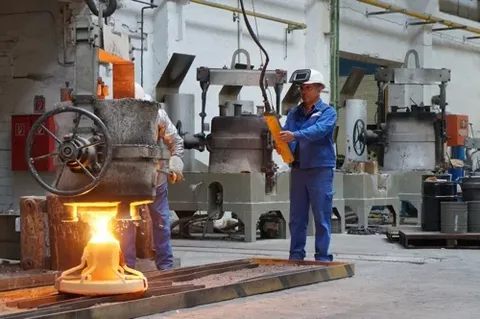In the world of modern manufacturing, precision, efficiency, and innovation are the driving forces behind every successful production process. Two of the most fundamental and time-tested technologies that continue to shape industries are lathe machines and metal casting. Together, they form the foundation of mechanical engineering and industrial fabrication — producing everything from intricate components to massive machinery parts with exact precision and strength.
Whether in automotive production, aerospace, construction, or toolmaking, the integration of metal casting and lathe machining plays a vital role in creating durable, high-quality, and performance-driven products.
Understanding Metal Casting
Metal casting is one of the oldest and most essential manufacturing techniques in human history. It involves melting metal and pouring it into a mold to form a desired shape. Once cooled and solidified, the casting is removed and finished to create a usable component.
The process can be used for simple designs like gears and bolts or complex machinery parts requiring extreme precision. Common metals used in casting include iron, aluminum, brass, bronze, and steel — each offering distinct advantages based on application.
Key Advantages of Metal Casting
- Design Flexibility: Metal casting allows complex shapes that are impossible to achieve through other methods.
- Material Versatility: A wide variety of metals and alloys can be used.
- Cost-Effective for Mass Production: Ideal for producing large quantities of identical parts.
- Durability: Cast metals offer excellent mechanical strength and longevity.
- Customizability: Molds can be designed according to specific industrial requirements.
From automobile engine blocks to architectural fittings, metal casting remains one of the most efficient ways to produce durable and versatile metal components.
Common Types of Metal Casting
Different industries require different casting methods, depending on the part size, complexity, and metal type. The most common types include:
- Sand Casting: The most traditional and widely used process, ideal for large or complex parts.
- Die Casting: Used for mass production of small components with high precision.
- Investment Casting: Creates detailed and intricate shapes with smooth surfaces.
- Centrifugal Casting: Used for cylindrical parts like pipes and rings.
- Permanent Mold Casting: Delivers consistent results for medium to high-volume production.
Modern foundries use digital modeling, CNC machining, and automated pouring systems to make metal casting more efficient, accurate, and sustainable.
Introduction to Lathe Machines
A lathe machine is one of the most essential tools in the manufacturing and machining industry. It is primarily used to shape and machine materials — especially metals — by rotating the workpiece against a cutting tool.
Often referred to as the “mother of all machines,” the lathe forms the base for many other precision tools used in production workshops.
Working Principle of a Lathe Machine
In a lathe, the workpiece is clamped onto a spindle and rotated at high speed. A cutting tool is then applied to the rotating surface to remove material and achieve the desired shape or finish. This process is called “turning.”
Types of Lathe Machines
Depending on their design and purpose, lathe machines come in several varieties:
1. Engine Lathe
The most common type, suitable for a wide range of turning, facing, and drilling operations.
2. Turret Lathe
Designed for repetitive production work, allowing quick tool changes for multiple operations.
3. CNC Lathe (Computer Numerical Control)
The most advanced type, programmed via computer for precision and automation. CNC lathes are used for mass production of parts requiring extremely tight tolerances.
4. Tool Room Lathe
Used in manufacturing tool components and precision parts where accuracy is critical.
5. Special Purpose Lathe
Customized for specific operations such as crankshaft turning or glass working.
Each type of lathe serves unique industrial needs, but all share the same goal — precision shaping of materials to achieve consistent, high-quality results.
The Connection Between Metal Casting and Lathe Machines
While metal casting is the process of forming metal parts, lathe machines are used to refine, finish, and perfect those cast components. The relationship between the two processes is integral in manufacturing.
- Casting Creates the Base Shape:
Metal casting produces the initial form of a component — such as a gear, cylinder, or shaft. - Lathe Machine Enhances Precision:
The lathe machine then processes these cast components to ensure exact dimensions, smooth surfaces, and perfect alignment. - Machining for Tolerances:
Casting cannot always achieve tight tolerances; therefore, lathe machining ensures perfect fitting and function in assembly lines or engines. - Surface Finishing:
The lathe gives cast components their final texture, polish, and appearance, making them ready for industrial or commercial use.
In short, metal casting provides the shape — the lathe machine gives it perfection.
Industrial Applications of Lathe Machines and Metal Casting
The combination of lathe machines and metal casting supports a wide range of industries, including:
- Automotive: Engine parts, crankshafts, pistons, and transmission components.
- Aerospace: Precision castings and turned components for aircraft engines.
- Construction: Structural parts and equipment fittings.
- Marine: Propellers, shafts, and corrosion-resistant components.
- Energy & Power: Turbine parts, valves, and heavy-duty castings.
- Manufacturing Tools: Machine beds, spindles, and precision gears.
From massive industrial machinery to delicate precision tools, both technologies play an essential role in ensuring accuracy and durability.
Benefits of Combining Metal Casting and Machining
When metal casting and lathe machining are integrated in production, the results are unmatched in terms of quality and cost efficiency.
1. Reduced Production Time
Castings provide a near-net shape, reducing the amount of material that needs machining.
2. Lower Costs
Using cast metal blanks minimizes waste and saves on raw material expenses.
3. Improved Precision
Lathe finishing ensures tight tolerances for complex assemblies.
4. Enhanced Performance
Combined processes improve the strength, balance, and surface quality of components.
5. Customization Flexibility
Both casting molds and machining programs can be customized for specialized designs and small-batch production.
The Future of Metal Casting and Lathe Machining
With Industry 4.0 and the rise of automation, both lathe machines and metal casting are evolving rapidly. Modern foundries and machining shops are using digital simulations, robotics, and computer-controlled systems to improve efficiency and accuracy.
- CNC Integration: Precision machining using automated control systems.
- Additive Manufacturing: Combining 3D printing with casting for hybrid production.
- Sustainability: Use of recycled metals and energy-efficient furnaces.
- Smart Machining: IoT-enabled machines for real-time performance monitoring.
These innovations are making the manufacturing process faster, cleaner, and more sustainable — without compromising quality.
Conclusion
Both lathe machines and metal casting form the backbone of modern manufacturing. While metal casting provides the fundamental shape and structure of a component, the lathe machine refines and perfects it into a precision-engineered product.
Together, they create a synergy that supports industries worldwide — from automotive to aerospace, and from heavy machinery to consumer products.







